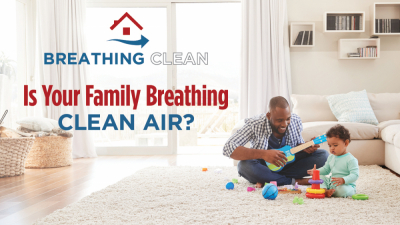How Much do You Know about Hidden Health Hazards in Your Home?
Anyone with young kids knows the list is quite long of things that pose health and safety concerns in the home. Typical homes have things like detergent pods that look like candy, and more choking and/or suffocating hazards than one can count. In addition, parents work hard to make sure that prescription drugs, chemicals, and household cleaners are out of reach, and furniture and appliances that may fall on a child are tethered to the wall. Homes may have hidden hazards like faulty wires, wet floors, and unstable stairs, and don’t even get us started on lead-based paints and asbestos.
Yet one of the most prolific hidden home hazards is the air our families breathe each and every day.

When was the last time you thought about your indoor air quality?
When we think of poor air quality, we tend to think of outdoor pollution generated in busy cities, by farms with greenhouse gases, or pollution caused by manufacturing facilities. The truth is, we’re all at risk with the air we breathe indoors as well. According to the Environmental Protection Association (EPA), indoor air can be three to five times more contaminated than outdoor air! And since we spend about 80 to 90% of our time indoors, the quality of indoor air can have a profound impact on the health of everyone around us.
According to the Asthma and Allergy Foundation of America (AAFA), more than 60 million Americans suffer from asthma and/or allergies, with common symptoms including itchy eyes, runny noses, sneezing, coughing, and even hives, wheezing, and difficulty breathing for some.
While many seasonal allergies are generated by pollen and other outdoor nuisances, our homes also harbor all sorts of indoor allergens. Many of these can be especially harmful, and can cause chronic suffering and asthma — especially for those who are more susceptible, like young children and the elderly, or anyone who suffers from chronic respiratory problems or auto-immune disorders.
Wondering what’s lurking in your indoor air? With simple everyday activities, we generate all sorts of contaminants and air pollutants like dirt, dust, pet dander, cigarette smoke, and chemicals. Mold and mildew are perhaps the most bothersome allergens, and can lurk all around your home. If left undetected or ignored, mold growth can turn into a serious issue, not only for the structure of your home, but for the health of those living under its roof.
Remember, just because you can’t see indoor pollutants doesn’t mean they’re not there! In fact, common indoor pollutants tend to be tiny particles — most so small they can’t be seen by the naked eye! Some pollutants remain airborne, while others settle on surfaces. But almost all allergens and contaminants in your home are pulled into the heating and air conditioning system, which takes air in and pushes air out, and recirculates all those contaminants five to seven times per day on average!
Keep in mind that as all those allergens circulate in your indoor air, they also move through your air ducts! Think about it—every time your air conditioning or heating is running, those harmful particles spread throughout your home, and then recirculate multiple times a day!
Poor indoor air can increase symptoms for those already dealing with allergies, asthma, and other respiratory problems, but anyone can be affected, with symptoms ranging from coughing, sneezing, dizziness, and headaches, to more severe health effects like damage to the heart, liver, or kidneys.
There are lots of ways to combat contaminants in the air your family breathes, such as changing your air filters every month; ensuring your home has sufficient ventilation; dusting, mopping, and vacuuming frequently; regularly washing linens; and bathing your trusty Fido.
Best of all, having your air ducts properly cleaned can improve your indoor air quality and reduce health problems by reducing the number of airborne pollutants circulating in your home!
Considering air duct cleaning? We’ve got all the answers to the Top Five Questions that homeowners ask about cleaning those air ducts!
Click Here for the Top Five FAQs About Air Duct Cleaning.
When you’re ready to get your ducts professionally cleaned, make sure you choose a qualified contractor who can get the job done right. NADCA makes it really simple for homeowners to find the best-of-the-best professionals when it comes to HVAC system cleaning! NADCA members have technicians on staff with advanced training and certification in air duct cleaning. All it takes is a zip code to search our online directory to find a NADCA member in your area.
